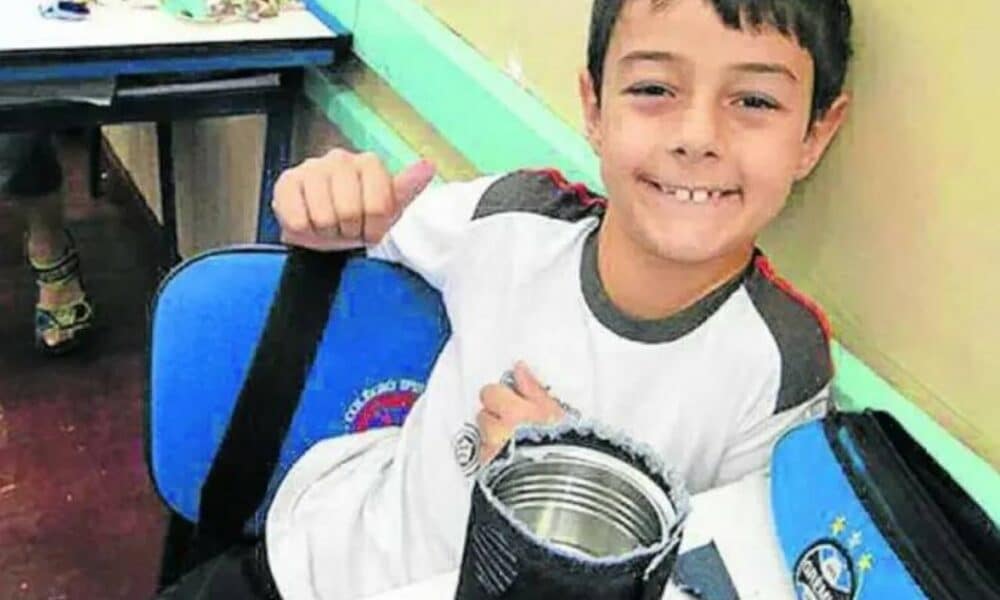In April 2014, the disappearance of Bernardo Uglione Boldrini, an 11-year-old boy, in Três Passos, a city in northwestern Rio Grande do Sul, triggered an investigation that uncovered one of the most shocking crimes in recent Brazilian history. Ten days after his disappearance, Bernardo’s body was found buried in a vertical pit on the banks of the Mico River in Frederico Westphalen, a neighboring city. The case, involving the boy’s father, stepmother, and two of their acquaintances, revealed a cruel scheme driven by family conflicts and financial interests. The brutality of the murder, coupled with failures in the child protection system, sparked nationwide outrage and debates that remain relevant over a decade later. The 2019 trial of the four involved was a milestone in Rio Grande do Sul’s justice system, but questions about punishment and prevention of similar cases persist.
Bernardo was known in the Três Passos community as a cheerful and outgoing boy, but his family life was marked by tension. After his mother, Odilaine Uglione, died in 2010, he began living with his father, Leandro Boldrini, and stepmother, Graciele Ugulini. Reports of mistreatment and neglect surfaced, with Bernardo reporting the hostile home environment to his school and local authorities. Despite these complaints, protective measures were insufficient to prevent the tragedy. The Bernardo case became a symbol of gaps in the social assistance system and inspired changes in public policies aimed at protecting vulnerable children.
The investigation revealed that Bernardo was killed by an overdose of midazolam, a controlled sedative, intentionally administered. The crime was planned by Leandro, Graciele, Edelvania Wirganovicz, and Evandro Wirganovicz, who acted together to carry out and conceal the murder. The discovery of the body, guided by Edelvania’s confession, stunned the public and placed Três Passos at the center of national attention. More than ten years after the crime, the case continues to spark discussions about justice, family responsibility, and the need to strengthen child protection networks.
- Key facts of the Bernardo Boldrini case:
- Disappearance on April 4, 2014, in Três Passos.
- Body found on April 14, 2014, in Frederico Westphalen.
- Involvement of four individuals: Leandro Boldrini, Graciele Ugulini, Edelvania, and Evandro Wirganovicz.
- Convictions in 2019, with sentences ranging from 9 to 34 years in prison.
Family context and early warning signs
Bernardo Uglione Boldrini was born in 2003 and spent his early years in a seemingly stable environment. His mother, Odilaine Uglione, was a nurse and maintained a close relationship with her son. In 2010, Odilaine was found dead in a medical clinic in Três Passos, in a case initially treated as suicide. Her death marked a turning point in Bernardo’s life, as he began living solely with his father, Leandro Boldrini, a well-known doctor in the region. Leandro soon started a relationship with Graciele Ugulini, who became Bernardo’s stepmother and played a central role in the family dynamics.
Living with Graciele was fraught with conflict. Neighbors and teachers reported that Bernardo showed signs of sadness and withdrawal, contrasting with his outgoing personality. The boy reported instances of mistreatment to the Guardianship Council and the Public Prosecutor’s Office, describing neglect and psychological abuse. In a handwritten letter, Bernardo expressed his desire to live with another family, revealing the suffering he endured. Despite these reports, local authorities failed to take effective action, allowing the situation to escalate to its tragic conclusion.
The inheritance left by Odilaine became a central factor in the case. According to investigations, Leandro and Graciele saw Bernardo as an obstacle to controlling the family’s assets. The strained relationship with the boy, combined with financial interests, created a fertile ground for planning the crime. The lack of intervention by responsible institutions exacerbated Bernardo’s vulnerability, highlighting systemic failures that would be widely debated after the murder came to light.
Planning and execution of the crime
Bernardo’s murder was meticulously planned by the four involved parties. On April 4, 2014, Graciele Ugulini took the boy to Frederico Westphalen under the pretext of visiting a spiritual healer, a strategy to remove him from Três Passos without arousing suspicion. During the trip, Bernardo was given a lethal dose of midazolam, a drug to which Graciele, a trained nurse, had access. The boy died from the overdose, and his body was placed in a plastic bag for transport.
Edelvania Wirganovicz, a friend of Graciele, played an active role in executing the plan. She assisted in transporting the body and selecting the burial site. Evandro Wirganovicz, Edelvania’s brother, was responsible for digging the vertical pit on the banks of the Mico River, in a rural area of Frederico Westphalen. The coldness of the perpetrators shocked investigators, particularly because Leandro Boldrini, Bernardo’s father, continued his routine as usual, even filing a false missing person report.
The concealment of the body was designed to hinder discovery. The pit, about 1.5 meters deep, was covered with soil and vegetation, making it nearly invisible. However, Edelvania’s confession, prompted by investigative pressure, led authorities to the exact location on April 14, 2014. The discovery of the body marked the beginning of a series of arrests and revealed the extent of the crime’s cruelty, involving not only physical violence but also manipulation and detailed planning.
Investigation and arrests
The Três Passos Civil Police took charge of the case immediately after Bernardo’s disappearance was reported. Early suspicions fell on Leandro Boldrini, who presented inconsistencies in his testimony. Community pressure and intense media coverage accelerated the investigation, which gained momentum with the arrest of Graciele Ugulini on April 10, 2014. Graciele denied involvement in the crime, but evidence, including phone records and witness statements, pointed to her participation.
Edelvania Wirganovicz was arrested on the same day as Graciele, and her confession was pivotal to the investigation’s outcome. She admitted to helping conceal the body and indicated the precise location of the pit, enabling the recovery of Bernardo’s remains. Evandro Wirganovicz, Edelvania’s brother, was also arrested, accused of digging the pit and assisting in the concealment. Leandro Boldrini was detained on April 14, after the body was found, accused of being the mastermind behind the crime.
Forensic analysis confirmed that Bernardo died from acute intoxication caused by midazolam. Psychological and medical reports presented during the investigation indicated that the boy had suffered months of mistreatment, with signs of physical and emotional abuse. The Public Prosecutor’s Office highlighted the premeditation and cruelty of the crime, classifying it as quadruple aggravated homicide, with aggravating factors such as base motives, cruel means, the victim’s inability to defend himself, and violence against a minor under 14.
- Key milestones in the Bernardo case investigation:
- April 4, 2014: Bernardo disappears in Três Passos.
- April 10, 2014: Graciele and Edelvania are arrested.
- April 14, 2014: Bernardo’s body is found; Leandro and Evandro are arrested.
- 2014-2019: Investigations and trial preparations.
Historic trial in Três Passos
The trial of the four individuals involved in the Bernardo case, held from March 11 to 15, 2019, was one of the most anticipated in Rio Grande do Sul’s history. Presided over by Judge Sucilene Engler, the Três Passos Jury Court heard over 50 hours of testimonies, videos, audio recordings, and forensic evidence. Media coverage turned the event into a milestone, with live broadcasts and widespread social media discussions.
Graciele Ugulini was sentenced to 34 years and 7 months in prison for quadruple aggravated homicide and concealment of a corpse. The ruling emphasized her direct responsibility for administering the midazolam and leading the plan. Leandro Boldrini received 33 years and 8 months in prison, identified as the intellectual mastermind of the crime. The judge highlighted his “extraordinary perversity” and lack of remorse, particularly given his role as the victim’s father.
Edelvania Wirganovicz was sentenced to 22 years and 10 months for triple aggravated homicide and concealment of a corpse. Her cooperation with authorities, while aiding in locating the body, did not significantly reduce her sentence due to the severity of her involvement. Evandro Wirganovicz, considered a secondary accomplice, received 9 years and 6 months in prison, serving part of his sentence in a semi-open regime and obtaining parole on March 25, 2019.
Public reaction and Leandro’s trial annulment
The Bernardo case sparked outrage across Brazil, with protests in Três Passos and other cities in Rio Grande do Sul. The story of a boy who sought help before being murdered resonated deeply with the public, raising questions about the effectiveness of child protection mechanisms. Schools, guardianship councils, and social services faced increased scrutiny for better oversight in cases of suspected mistreatment.
In December 2021, the Rio Grande do Sul Court of Justice (TJRS) annulled Leandro Boldrini’s trial by a 4-3 vote. The decision, based on irregularities in the prosecutor’s conduct during questioning, stirred controversy. Some saw the annulment as a chance to review the case, while others viewed it as an affront to justice. As of April 2025, Leandro’s new trial had not yet been scheduled, keeping the case unresolved.
The annulment did not affect the convictions of Graciele, Edelvania, and Evandro, who continued serving their sentences. Graciele remains in a closed regime at the Madre Pelletier Women’s Prison in Porto Alegre, while Edelvania, before her death in 2025, was in a semi-open regime at the Porto Alegre Women’s Penal Institute. Evandro’s parole, meanwhile, drew criticism from the community, which questioned the brevity of his sentence.
Edelvania Wirganovicz’s prison trajectory
Edelvania Wirganovicz, a central figure in the case, entered the prison system in April 2014 following her arrest. Initially, she was held in a closed regime at the Madre Pelletier Women’s Prison. In May 2022, after serving over 9 years of her sentence, Edelvania progressed to a semi-open regime and was transferred to the Porto Alegre Women’s Penal Institute. The decision, made by Judge Geraldo Anastácio Brandeburski Júnior, was based on her good prison conduct and favorable psychological evaluations.
In 2023, Edelvania was granted house arrest with electronic monitoring due to a lack of space in facilities suitable for the semi-open regime. The measure, authorized on October 10, 2023, was revoked on February 20, 2025, following an appeal by the Public Prosecutor’s Office, which argued that she had not served 50% of her sentence, a requirement for the benefit. Edelvania returned to the Women’s Penal Institute, where she was found lifeless on April 22, 2025, with signs of asphyxiation, in a case currently under investigation.
Edelvania’s death reignited debates about prison conditions and the safety of inmates in high-profile cases. The Women’s Penal Institute, with a capacity for 96 inmates, is equipped with surveillance cameras, but incidents like this highlight vulnerabilities in the system. The Superintendence of Penitentiary Services (Susepe) stated that the Civil Police and the General Institute of Forensics are investigating the circumstances of the death.
- Milestones in Edelvania’s prison trajectory:
- 2014: Arrested and held in a closed regime at Madre Pelletier Prison.
- 2022: Progressed to semi-open regime at the Women’s Penal Institute.
- 2023: Granted house arrest with electronic monitoring.
- 2025: House arrest revoked and death in prison.
Failures in child protection
The Bernardo Boldrini case exposed serious flaws in Brazil’s child protection system. Before his death, the boy sought help from various entities, including his school, the Guardianship Council, and the Public Prosecutor’s Office. His reports, however, did not lead to effective actions to remove him from the dangerous environment. Teachers noted signs of distress in Bernardo, but the lack of coordination among responsible agencies allowed him to remain under Leandro and Graciele’s care.
Following the tragedy, Rio Grande do Sul implemented measures to strengthen the child protection network. In 2015, the state government launched the Child and Adolescent Protection Program, expanding training for guardianship counselors and educators to identify signs of abuse. The promotion of anonymous reporting channels, such as Disque 100, was also encouraged, though implementation faces challenges in rural areas like Três Passos.
Experts emphasize that cases like Bernardo’s require an integrated approach, involving schools, healthcare services, social assistance, and the judiciary. Limited resources and bureaucracy remain obstacles to the effectiveness of these policies. The case also underscored the importance of listening to children, who are often overlooked in family conflict situations.
Cultural and media impact
The murder of Bernardo Boldrini transcended Três Passos, becoming one of Brazil’s most notorious criminal cases. The local and national press provided extensive coverage, with reports, documentaries, and TV programs delving into the case’s details. The story inspired books and series that portrayed the tragedy and its social implications. While media exposure pressured authorities, it also faced criticism for sensationalism at times.
On social media, the case mobilized thousands, with campaigns demanding justice and reforms in child protection. Hashtags like #JusticeForBernardo went viral in 2014 and 2019 during the trial. Bernardo’s memory remains alive in Três Passos, where plaques and memorials have been erected in his honor. The city, scarred by the tragedy, seeks to overcome its stigma while strengthening community initiatives to protect its children.
Bernardo’s story also influenced legislation. In 2016, Law 13,257, known as the Early Childhood Legal Framework, was enacted, establishing guidelines for protecting children aged 0 to 6. Though focused on younger ages than Bernardo’s, the law reflects efforts to prioritize childhood in public policy, an indirect legacy of the case.
Prison system and current challenges
The Rio Grande do Sul prison system, where Edelvania Wirganovicz and Graciele Ugulini served their sentences, faces structural challenges that impact the management of high-profile cases. The Porto Alegre Women’s Penal Institute, where Edelvania was found dead, is one of the few facilities for women in the state. With limited capacity and scarce resources, the unit struggles to meet demands for security, rehabilitation, and psychological support.
Edelvania’s death in 2025 raised questions about monitoring protocols in prisons. Despite the Women’s Penal Institute being equipped with surveillance cameras and trained staff, incidents like this expose system vulnerabilities. Susepe announced a review of internal procedures, but pressure for broader reforms persists. Overcrowding, lack of space, and the poor condition of some facilities are ongoing issues in Rio Grande do Sul.
Graciele Ugulini, serving a closed-regime sentence, also faces challenges in the prison system. Her status as a high-profile convict requires special measures, such as solitary confinement, for her safety. Managing inmates in cases of significant public outcry demands a balance between punishment, rehabilitation, and protection, a challenge the Rio Grande do Sul prison system continues to address.
Bernardo Boldrini’s legacy
The tragedy of Bernardo Boldrini left deep scars in Rio Grande do Sul society. His story inspired community initiatives, such as support groups for at-risk children, and reinforced the importance of listening to victims of domestic violence. Schools in Três Passos adopted awareness programs, teaching students to recognize and report abuse. The local protection network was restructured, with greater integration among guardianship councils, schools, and judicial bodies.
The case also impacted the judiciary. The annulment of Leandro Boldrini’s trial, though controversial, highlighted the need for procedural rigor in high-visibility cases. The delay in scheduling a new trial, however, frustrates parts of the public, who demand swift justice. The fight for justice for Bernardo continues, as society reflects on preventing future tragedies.
Bernardo’s memory serves as a call to action. His story underscores that child protection requires collective effort, involving families, communities, and institutions. As the case continues to influence public policy and social debates, Bernardo’s legacy is a reminder of the importance of prioritizing children’s safety and well-being.
- Measures to strengthen child protection:
- Training for teachers and guardianship counselors to identify signs of abuse.
- Expansion of anonymous reporting channels, such as Disque 100.
- Integration of schools, healthcare, and social services.
- Investment in domestic violence prevention programs.

In April 2014, the disappearance of Bernardo Uglione Boldrini, an 11-year-old boy, in Três Passos, a city in northwestern Rio Grande do Sul, triggered an investigation that uncovered one of the most shocking crimes in recent Brazilian history. Ten days after his disappearance, Bernardo’s body was found buried in a vertical pit on the banks of the Mico River in Frederico Westphalen, a neighboring city. The case, involving the boy’s father, stepmother, and two of their acquaintances, revealed a cruel scheme driven by family conflicts and financial interests. The brutality of the murder, coupled with failures in the child protection system, sparked nationwide outrage and debates that remain relevant over a decade later. The 2019 trial of the four involved was a milestone in Rio Grande do Sul’s justice system, but questions about punishment and prevention of similar cases persist.
Bernardo was known in the Três Passos community as a cheerful and outgoing boy, but his family life was marked by tension. After his mother, Odilaine Uglione, died in 2010, he began living with his father, Leandro Boldrini, and stepmother, Graciele Ugulini. Reports of mistreatment and neglect surfaced, with Bernardo reporting the hostile home environment to his school and local authorities. Despite these complaints, protective measures were insufficient to prevent the tragedy. The Bernardo case became a symbol of gaps in the social assistance system and inspired changes in public policies aimed at protecting vulnerable children.
The investigation revealed that Bernardo was killed by an overdose of midazolam, a controlled sedative, intentionally administered. The crime was planned by Leandro, Graciele, Edelvania Wirganovicz, and Evandro Wirganovicz, who acted together to carry out and conceal the murder. The discovery of the body, guided by Edelvania’s confession, stunned the public and placed Três Passos at the center of national attention. More than ten years after the crime, the case continues to spark discussions about justice, family responsibility, and the need to strengthen child protection networks.
- Key facts of the Bernardo Boldrini case:
- Disappearance on April 4, 2014, in Três Passos.
- Body found on April 14, 2014, in Frederico Westphalen.
- Involvement of four individuals: Leandro Boldrini, Graciele Ugulini, Edelvania, and Evandro Wirganovicz.
- Convictions in 2019, with sentences ranging from 9 to 34 years in prison.
Family context and early warning signs
Bernardo Uglione Boldrini was born in 2003 and spent his early years in a seemingly stable environment. His mother, Odilaine Uglione, was a nurse and maintained a close relationship with her son. In 2010, Odilaine was found dead in a medical clinic in Três Passos, in a case initially treated as suicide. Her death marked a turning point in Bernardo’s life, as he began living solely with his father, Leandro Boldrini, a well-known doctor in the region. Leandro soon started a relationship with Graciele Ugulini, who became Bernardo’s stepmother and played a central role in the family dynamics.
Living with Graciele was fraught with conflict. Neighbors and teachers reported that Bernardo showed signs of sadness and withdrawal, contrasting with his outgoing personality. The boy reported instances of mistreatment to the Guardianship Council and the Public Prosecutor’s Office, describing neglect and psychological abuse. In a handwritten letter, Bernardo expressed his desire to live with another family, revealing the suffering he endured. Despite these reports, local authorities failed to take effective action, allowing the situation to escalate to its tragic conclusion.
The inheritance left by Odilaine became a central factor in the case. According to investigations, Leandro and Graciele saw Bernardo as an obstacle to controlling the family’s assets. The strained relationship with the boy, combined with financial interests, created a fertile ground for planning the crime. The lack of intervention by responsible institutions exacerbated Bernardo’s vulnerability, highlighting systemic failures that would be widely debated after the murder came to light.
Planning and execution of the crime
Bernardo’s murder was meticulously planned by the four involved parties. On April 4, 2014, Graciele Ugulini took the boy to Frederico Westphalen under the pretext of visiting a spiritual healer, a strategy to remove him from Três Passos without arousing suspicion. During the trip, Bernardo was given a lethal dose of midazolam, a drug to which Graciele, a trained nurse, had access. The boy died from the overdose, and his body was placed in a plastic bag for transport.
Edelvania Wirganovicz, a friend of Graciele, played an active role in executing the plan. She assisted in transporting the body and selecting the burial site. Evandro Wirganovicz, Edelvania’s brother, was responsible for digging the vertical pit on the banks of the Mico River, in a rural area of Frederico Westphalen. The coldness of the perpetrators shocked investigators, particularly because Leandro Boldrini, Bernardo’s father, continued his routine as usual, even filing a false missing person report.
The concealment of the body was designed to hinder discovery. The pit, about 1.5 meters deep, was covered with soil and vegetation, making it nearly invisible. However, Edelvania’s confession, prompted by investigative pressure, led authorities to the exact location on April 14, 2014. The discovery of the body marked the beginning of a series of arrests and revealed the extent of the crime’s cruelty, involving not only physical violence but also manipulation and detailed planning.
Investigation and arrests
The Três Passos Civil Police took charge of the case immediately after Bernardo’s disappearance was reported. Early suspicions fell on Leandro Boldrini, who presented inconsistencies in his testimony. Community pressure and intense media coverage accelerated the investigation, which gained momentum with the arrest of Graciele Ugulini on April 10, 2014. Graciele denied involvement in the crime, but evidence, including phone records and witness statements, pointed to her participation.
Edelvania Wirganovicz was arrested on the same day as Graciele, and her confession was pivotal to the investigation’s outcome. She admitted to helping conceal the body and indicated the precise location of the pit, enabling the recovery of Bernardo’s remains. Evandro Wirganovicz, Edelvania’s brother, was also arrested, accused of digging the pit and assisting in the concealment. Leandro Boldrini was detained on April 14, after the body was found, accused of being the mastermind behind the crime.
Forensic analysis confirmed that Bernardo died from acute intoxication caused by midazolam. Psychological and medical reports presented during the investigation indicated that the boy had suffered months of mistreatment, with signs of physical and emotional abuse. The Public Prosecutor’s Office highlighted the premeditation and cruelty of the crime, classifying it as quadruple aggravated homicide, with aggravating factors such as base motives, cruel means, the victim’s inability to defend himself, and violence against a minor under 14.
- Key milestones in the Bernardo case investigation:
- April 4, 2014: Bernardo disappears in Três Passos.
- April 10, 2014: Graciele and Edelvania are arrested.
- April 14, 2014: Bernardo’s body is found; Leandro and Evandro are arrested.
- 2014-2019: Investigations and trial preparations.
Historic trial in Três Passos
The trial of the four individuals involved in the Bernardo case, held from March 11 to 15, 2019, was one of the most anticipated in Rio Grande do Sul’s history. Presided over by Judge Sucilene Engler, the Três Passos Jury Court heard over 50 hours of testimonies, videos, audio recordings, and forensic evidence. Media coverage turned the event into a milestone, with live broadcasts and widespread social media discussions.
Graciele Ugulini was sentenced to 34 years and 7 months in prison for quadruple aggravated homicide and concealment of a corpse. The ruling emphasized her direct responsibility for administering the midazolam and leading the plan. Leandro Boldrini received 33 years and 8 months in prison, identified as the intellectual mastermind of the crime. The judge highlighted his “extraordinary perversity” and lack of remorse, particularly given his role as the victim’s father.
Edelvania Wirganovicz was sentenced to 22 years and 10 months for triple aggravated homicide and concealment of a corpse. Her cooperation with authorities, while aiding in locating the body, did not significantly reduce her sentence due to the severity of her involvement. Evandro Wirganovicz, considered a secondary accomplice, received 9 years and 6 months in prison, serving part of his sentence in a semi-open regime and obtaining parole on March 25, 2019.
Public reaction and Leandro’s trial annulment
The Bernardo case sparked outrage across Brazil, with protests in Três Passos and other cities in Rio Grande do Sul. The story of a boy who sought help before being murdered resonated deeply with the public, raising questions about the effectiveness of child protection mechanisms. Schools, guardianship councils, and social services faced increased scrutiny for better oversight in cases of suspected mistreatment.
In December 2021, the Rio Grande do Sul Court of Justice (TJRS) annulled Leandro Boldrini’s trial by a 4-3 vote. The decision, based on irregularities in the prosecutor’s conduct during questioning, stirred controversy. Some saw the annulment as a chance to review the case, while others viewed it as an affront to justice. As of April 2025, Leandro’s new trial had not yet been scheduled, keeping the case unresolved.
The annulment did not affect the convictions of Graciele, Edelvania, and Evandro, who continued serving their sentences. Graciele remains in a closed regime at the Madre Pelletier Women’s Prison in Porto Alegre, while Edelvania, before her death in 2025, was in a semi-open regime at the Porto Alegre Women’s Penal Institute. Evandro’s parole, meanwhile, drew criticism from the community, which questioned the brevity of his sentence.
Edelvania Wirganovicz’s prison trajectory
Edelvania Wirganovicz, a central figure in the case, entered the prison system in April 2014 following her arrest. Initially, she was held in a closed regime at the Madre Pelletier Women’s Prison. In May 2022, after serving over 9 years of her sentence, Edelvania progressed to a semi-open regime and was transferred to the Porto Alegre Women’s Penal Institute. The decision, made by Judge Geraldo Anastácio Brandeburski Júnior, was based on her good prison conduct and favorable psychological evaluations.
In 2023, Edelvania was granted house arrest with electronic monitoring due to a lack of space in facilities suitable for the semi-open regime. The measure, authorized on October 10, 2023, was revoked on February 20, 2025, following an appeal by the Public Prosecutor’s Office, which argued that she had not served 50% of her sentence, a requirement for the benefit. Edelvania returned to the Women’s Penal Institute, where she was found lifeless on April 22, 2025, with signs of asphyxiation, in a case currently under investigation.
Edelvania’s death reignited debates about prison conditions and the safety of inmates in high-profile cases. The Women’s Penal Institute, with a capacity for 96 inmates, is equipped with surveillance cameras, but incidents like this highlight vulnerabilities in the system. The Superintendence of Penitentiary Services (Susepe) stated that the Civil Police and the General Institute of Forensics are investigating the circumstances of the death.
- Milestones in Edelvania’s prison trajectory:
- 2014: Arrested and held in a closed regime at Madre Pelletier Prison.
- 2022: Progressed to semi-open regime at the Women’s Penal Institute.
- 2023: Granted house arrest with electronic monitoring.
- 2025: House arrest revoked and death in prison.
Failures in child protection
The Bernardo Boldrini case exposed serious flaws in Brazil’s child protection system. Before his death, the boy sought help from various entities, including his school, the Guardianship Council, and the Public Prosecutor’s Office. His reports, however, did not lead to effective actions to remove him from the dangerous environment. Teachers noted signs of distress in Bernardo, but the lack of coordination among responsible agencies allowed him to remain under Leandro and Graciele’s care.
Following the tragedy, Rio Grande do Sul implemented measures to strengthen the child protection network. In 2015, the state government launched the Child and Adolescent Protection Program, expanding training for guardianship counselors and educators to identify signs of abuse. The promotion of anonymous reporting channels, such as Disque 100, was also encouraged, though implementation faces challenges in rural areas like Três Passos.
Experts emphasize that cases like Bernardo’s require an integrated approach, involving schools, healthcare services, social assistance, and the judiciary. Limited resources and bureaucracy remain obstacles to the effectiveness of these policies. The case also underscored the importance of listening to children, who are often overlooked in family conflict situations.
Cultural and media impact
The murder of Bernardo Boldrini transcended Três Passos, becoming one of Brazil’s most notorious criminal cases. The local and national press provided extensive coverage, with reports, documentaries, and TV programs delving into the case’s details. The story inspired books and series that portrayed the tragedy and its social implications. While media exposure pressured authorities, it also faced criticism for sensationalism at times.
On social media, the case mobilized thousands, with campaigns demanding justice and reforms in child protection. Hashtags like #JusticeForBernardo went viral in 2014 and 2019 during the trial. Bernardo’s memory remains alive in Três Passos, where plaques and memorials have been erected in his honor. The city, scarred by the tragedy, seeks to overcome its stigma while strengthening community initiatives to protect its children.
Bernardo’s story also influenced legislation. In 2016, Law 13,257, known as the Early Childhood Legal Framework, was enacted, establishing guidelines for protecting children aged 0 to 6. Though focused on younger ages than Bernardo’s, the law reflects efforts to prioritize childhood in public policy, an indirect legacy of the case.
Prison system and current challenges
The Rio Grande do Sul prison system, where Edelvania Wirganovicz and Graciele Ugulini served their sentences, faces structural challenges that impact the management of high-profile cases. The Porto Alegre Women’s Penal Institute, where Edelvania was found dead, is one of the few facilities for women in the state. With limited capacity and scarce resources, the unit struggles to meet demands for security, rehabilitation, and psychological support.
Edelvania’s death in 2025 raised questions about monitoring protocols in prisons. Despite the Women’s Penal Institute being equipped with surveillance cameras and trained staff, incidents like this expose system vulnerabilities. Susepe announced a review of internal procedures, but pressure for broader reforms persists. Overcrowding, lack of space, and the poor condition of some facilities are ongoing issues in Rio Grande do Sul.
Graciele Ugulini, serving a closed-regime sentence, also faces challenges in the prison system. Her status as a high-profile convict requires special measures, such as solitary confinement, for her safety. Managing inmates in cases of significant public outcry demands a balance between punishment, rehabilitation, and protection, a challenge the Rio Grande do Sul prison system continues to address.
Bernardo Boldrini’s legacy
The tragedy of Bernardo Boldrini left deep scars in Rio Grande do Sul society. His story inspired community initiatives, such as support groups for at-risk children, and reinforced the importance of listening to victims of domestic violence. Schools in Três Passos adopted awareness programs, teaching students to recognize and report abuse. The local protection network was restructured, with greater integration among guardianship councils, schools, and judicial bodies.
The case also impacted the judiciary. The annulment of Leandro Boldrini’s trial, though controversial, highlighted the need for procedural rigor in high-visibility cases. The delay in scheduling a new trial, however, frustrates parts of the public, who demand swift justice. The fight for justice for Bernardo continues, as society reflects on preventing future tragedies.
Bernardo’s memory serves as a call to action. His story underscores that child protection requires collective effort, involving families, communities, and institutions. As the case continues to influence public policy and social debates, Bernardo’s legacy is a reminder of the importance of prioritizing children’s safety and well-being.
- Measures to strengthen child protection:
- Training for teachers and guardianship counselors to identify signs of abuse.
- Expansion of anonymous reporting channels, such as Disque 100.
- Integration of schools, healthcare, and social services.
- Investment in domestic violence prevention programs.







